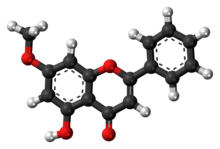 | |
 | |
| Names | |
|---|---|
| IUPAC name 5-Hydroxy-7-methoxyflavone | |
| Systematic IUPAC name 5-Hydroxy-7-methoxy-2-phenyl-4H-1-benzopyran-4-one | |
| Other names Tectochrysin Methyl chrysin 7-Methoxy-5-hydroxyflavone | |
| Identifiers | |
3D model (JSmol) | |
| ChEBI | |
| ChemSpider | |
| KEGG | |
PubChem CID | |
| UNII | |
CompTox Dashboard (EPA) | |
| |
| |
| Properties | |
| C16H12O4 | |
| Molar mass | 268.26 g/mol |
Except where otherwise noted, data are given for materials in their standard state (at 25 °C [77 °F], 100 kPa). | |
Techtochrysin is a chemical compound. It is an O-methylated flavone, a flavonoid isolated from Prunus cerasus, [1] the sour cherry, a plant native to much of Europe and southwest Asia.